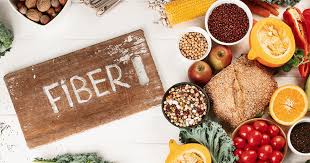Lower Fiber Food Choices: Understanding and Exploring Options 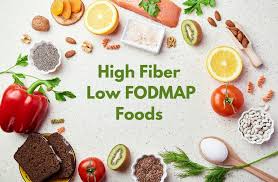
Fiber is an essential part of a healthy diet, known for its benefits in promoting digestive health, regulating blood sugar levels, and supporting heart health. However, there are situations when individuals might need to reduce their fiber intake temporarily. This could be due to certain medical conditions, digestive issues, or specific dietary plans. Understanding lower-fiber food choices can help individuals navigate these situations while still maintaining a balanced diet.
Understanding Dietary Fiber
Before diving into lower-fiber food choices, it’s important to understand what dietary fiber is and its functions. Dietary fiber is the indigestible part of plant foods, and it can be classified into two main categories:
- Soluble Fiber: This type dissolves in water and can help lower blood cholesterol and glucose levels. It is found in foods like oats, beans, and certain fruits.
- Insoluble Fiber: This type does not dissolve in water and helps add bulk to stool, promoting regularity. It is found in whole grains, nuts, seeds, and the skins of fruits and vegetables.
While fiber is crucial for digestive health, there are instances where a low-fiber diet may be recommended:
- Digestive Disorders: Conditions like Crohn’s disease, ulcerative colitis, and diverticulitis may require a temporary reduction in fiber to minimize irritation.
- Post-Surgery Recovery: Following gastrointestinal surgery, a low-fiber diet may help the digestive system heal.
- Certain Medical Tests: Before specific medical procedures or tests, doctors may recommend a low-fiber diet.
Benefits of Lower Fiber Foods
- Digestive Rest: Lower fiber foods can help give the digestive tract a break, which may be necessary for individuals with certain conditions.
- Ease of Digestion: Foods low in fiber are often easier to digest, making them suitable for people recovering from surgery or experiencing digestive distress.
- Nutrient Density: Some low-fiber foods are rich in essential nutrients, providing the body with the necessary vitamins and minerals without the bulk of fiber.
Lower Fiber Food Choices
When considering a lower-fiber diet, it’s important to select foods that are both nutritious and satisfying. Here’s a breakdown of various food categories with lower-fiber options:
- Grains and Cereals
Many whole grains are high in fiber, but there are refined grains that are lower in fiber and easier to digest:
- White Rice: A staple in many diets, white rice is low in fiber compared to brown rice. It’s easily digestible and can be a good base for meals.
- White Bread: Made from refined flour, white bread contains less fiber than whole grain breads. Look for brands that do not contain seeds or whole grains.
- Pasta: Traditional pasta made from refined flour is lower in fiber than whole grain or high-fiber pasta options. Cooking it until soft can aid digestion.
- Cornmeal: Used in many recipes, cornmeal is lower in fiber than whole corn products, making it a suitable choice for polenta or cornbread.
- Couscous: This semolina product is low in fiber and can be a versatile base for various dishes.
- Fruits
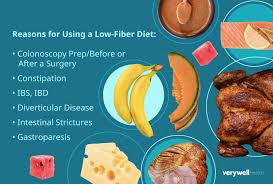
While many fruits are high in fiber, certain varieties are lower in fiber, especially when peeled or cooked:
- Bananas: Ripe bananas are low in fiber and easy to digest. They provide potassium and other nutrients.
- Melons: Watermelon and cantaloupe are hydrating fruits that are low in fiber and gentle on the digestive system.
- Applesauce: Unsweetened applesauce contains less fiber than whole apples, making it a good alternative for those needing lower fiber options.
- Canned Peaches: Choose those packed in juice or water rather than syrup. Canned peaches are lower in fiber than fresh ones and easier to digest.
- Avocado: While avocados are known for their healthy fats, they also contain less fiber when mashed or blended.
- Vegetables
Many vegetables are high in fiber, but some can be included in a lower-fiber diet:
- Cooked Carrots: When cooked, carrots become softer and easier to digest, while their fiber content is reduced.
- Potatoes: Peeled potatoes, especially when mashed, are lower in fiber than their skin-on counterparts.
- Pumpkin: Cooked pumpkin is nutritious and lower in fiber than raw pumpkin, making it a versatile ingredient.
- Zucchini: When cooked and peeled, zucchini can be a low-fiber addition to meals.
- Spinach: Cooked spinach has a reduced fiber content compared to raw spinach, making it a gentle choice.
- Dairy and Alternatives
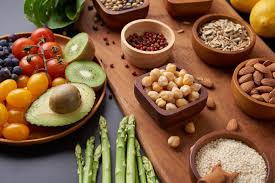
Dairy products can be low in fiber and provide essential nutrients:
- Yogurt: Plain yogurt, especially if strained (like Greek yogurt), contains no fiber and is probiotic-rich for digestive health.
- Cheese: Most cheeses are low in fiber and high in protein and calcium, making them a good addition to a low-fiber diet.
- Milk: Both cow’s milk and plant-based milks (such as almond or coconut) are low in fiber, providing hydration and essential nutrients.
- Proteins
Protein sources can vary widely in fiber content. Here are some lower-fiber options:
- Eggs: Eggs are an excellent source of protein and contain no fiber, making them easy to digest.
- Fish: Most fish and seafood are low in fiber and high in healthy fats and protein.
- Poultry: Chicken and turkey, especially when skinless and cooked, are low in fiber and rich in protein.
- Tofu: Soft or silken tofu is lower in fiber than other soy products and can be used in a variety of dishes.
- Fats and Oils
Fats and oils are typically free from fiber and can enhance flavor and satiety:
- Butter: A source of fat that adds richness to dishes without fiber.
- Oils: Olive oil, canola oil, and other cooking oils are low in fiber and can be used for cooking or dressings.
- Nut Butters: While whole nuts are high in fiber, smooth nut butters (like peanut or almond butter) have less fiber than their whole counterparts.
Sample Meal Ideas
To illustrate how to incorporate lower-fiber food choices, here are some sample meal ideas:
Breakfast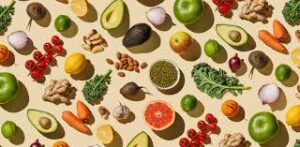
- Scrambled Eggs: Cooked with a bit of cheese and served with a side of white toast.
- Yogurt Parfait: Plain yogurt layered with a small amount of applesauce and a sprinkle of cinnamon.
Lunch
- Chicken and Rice: Grilled chicken served over white rice with a side of cooked carrots.
- Creamy Soup: A smooth, pureed soup (like potato or pumpkin) served with soft bread.
Dinner
- Baked Fish: A fillet of baked fish served with mashed potatoes and steamed zucchini.
- Pasta Dish: White pasta tossed in a light olive oil sauce with cooked spinach and grated cheese.
Snacks
- Cottage Cheese: A bowl of cottage cheese with canned peaches.
- Banana: A simple, ripe banana for a quick snack.
Transitioning Back to Higher Fiber Foods
Once the reason for a low-fiber diet has resolved, it’s essential to gradually reintroduce fiber-rich foods to avoid gastrointestinal distress. Here are some tips for transitioning back:
- Start Slowly: Begin by adding small amounts of fiber-rich foods to your diet, such as fruits, vegetables, and whole grains.
- Hydrate: Drink plenty of water as you increase your fiber intake to help prevent constipation.
- Mix and Match: Combine lower-fiber foods with higher-fiber options to ease the transition and provide a balanced diet.
- Monitor Reactions: Pay attention to how your body responds as you reintroduce fiber. Adjust your intake based on comfort and tolerance.
Conclusion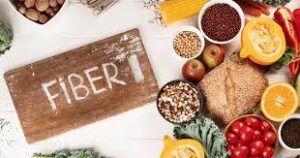
Lower-fiber food choices play a crucial role in specific dietary needs, particularly for individuals managing digestive disorders or recovering from surgery. Understanding these options allows for a balanced approach to nutrition, ensuring that individuals can still meet their dietary requirements without unnecessary discomfort. While fiber is an essential component of a healthy diet, there are times when reducing fiber can promote healing and comfort. By exploring a variety of lower-fiber foods, individuals can maintain a nutritious and satisfying diet that supports their health goals. Always consult with a healthcare provider or nutritionist when making significant dietary changes to ensure that individual needs are met effectively.

